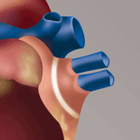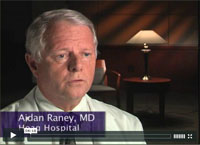Surgery for Atrial Fibrillation
 Atrial fibrillation is an abnormal heart rhythm, also known as an arrhythmia, that results in an impaired ability of the heart to pump blood to the body. Atrial fibrillation is the most common of all cardiac arrhythmias, affecting 2.2 to 5.1 million people in the United States. (1) The most common symptoms are palpitations, chest discomfort or shortness of breath, and other symptoms may include fatigue, dizziness and feeling faint. Atrial fibrillation may have serious consequences, including a risk of stroke that is five times the normal population. (2) Atrial fibrillation may also lead to congestive heart failure.
Atrial fibrillation is an abnormal heart rhythm, also known as an arrhythmia, that results in an impaired ability of the heart to pump blood to the body. Atrial fibrillation is the most common of all cardiac arrhythmias, affecting 2.2 to 5.1 million people in the United States. (1) The most common symptoms are palpitations, chest discomfort or shortness of breath, and other symptoms may include fatigue, dizziness and feeling faint. Atrial fibrillation may have serious consequences, including a risk of stroke that is five times the normal population. (2) Atrial fibrillation may also lead to congestive heart failure.
There are a variety of treatments for atrial fibrillation, including drug therapy, interventional procedures and surgery. Drug therapy includes anticoagulants (warfarin) and antiarrhythmics. Drug therapy is the first line of treatment, though there are side-effects associated with the different medications. (Please visit the American Heart Association for information on living with atrial fibrillation). Catheter ablation is also used to treat atrial fibrillation, and involves threading a small flexible tube (catheter) through the femoral vein in the groin up to the heart. Hot or cold energy is used to create small scars, or lesions, on certain parts of the heart to block the irregular electrical impulses that cause AF. This procedure has been effective in curing AF in about 39% of patients. If antiarrhythmic medication is continued, the success rate is about 76%. (3) Cardioversion may also be used to treat atrial fibrillation. In cardioversion, an electrical shock is delivered to the heart to force it back into normal rhythm. (More information on atrial fibrillation cardioversion)
Surgery for Atrial Fibrillation
The Modified Maze procedure is used in surgery for atrial fibrillation, and generally completed at the same time the patient is having another type of heart surgery, such as a coronary artery bypass or valve replacement. Because this is open-heart surgery, it only takes a few minutes to create the necessary set of lesions to block the irregular electrical impulses that cause AF. Experience shows this type of surgery can eliminate AF in about 96% of patients. (4) Side effects of this surgery are similar to other heart surgeries and will vary depending upon what’s being performed.
Minimally invasive surgery may also be performed for atrial fibrillation, also known as the "Mini Maze Procedure." Early research shows that this type of surgery may eliminate atrial fibrillation in about 91% of patients. (5)
The specific treatment plan for atrial fibrillation is a complex decision and involves the input of multiple doctors, including internists, cardiologists, and a cardiac surgeon. If you would like to discuss your situation with a heart surgeon, please contact us to schedule an appointment.
References
1. American Heart Association. Heart Disease and Stroke Statistics – 2005 Update. Dallas, Tex.: American Heart Association; 2004.
2. Wolf PA, Abbott RD, Kannel WB. Atrial fibrillation as an independent risk factor for stroke: the Framingham study. Stroke. 1991; 22:983-988.
3. Cappato R, Calkins H, Chen S et al. Worldwide survey on the methods, efficacy and safety of catheter ablation for human atrial fibrillation. Circulation 2005;111:1100-1105.
4. Prasad SM, Maniar HS, Camillo CJ, Schuessler, RB et al. The Cox maze III procedure for atrial fibrillation: Long-term efficacy in patients undergoing lone versus concomitant procedures. J Thorac Cardiovasc Surg 2003;126:1822-8.
5. Wolf RK, Schneeberger EW, Osterday R, et al. Video-assisted bilateral pulmonary vein isolation and left atrial appendage exclusion for atrial fibrillation. J Thorac Cardiovasc Surg 2005;130(7):797-802.
 Email Article
Email Article 
